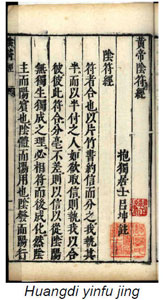The Huangdi Yinfujing — Yellow Emperor’s Hidden Talisman Classic

Source: Wikipedia, the free encyclopedia
The Huangdi Yinfujing (黃帝陰符經; literally “Yellow Emperor’s Hidden Talisman Classic”), or Yinfujing, is a circa 8th century CE Daoist scripture associated with internal alchemy lineages in general and the Quanzhen Taoism school in particular. In addition, Huangdi Yinfujing is also the name of a Chinese Fengshui text on military strategy.
- Texts
- Translations
- Title
- References
- See also
- External links
- Original text in Chinese
Texts
There are two received versions of the Daoist Huangdi Yinfujing, a shorter text of 332 Chinese characters in one section and a longer one of 445 in three sections. Both versions of this classic explain cosmological correspondences, the Dao of Heaven, Yin and Yang, the five elements, and biospiritual techniques. In the description of Alexander Wylie (1867:216), “This short Treatise, which is not entirely free from the obscurity of Tâoist mysticism, professes to reconcile the decrees of Heaven with the current of mundane affairs.” In the explanation of the modern Daoists Zhang Jiyu and Li Yuanguo,
 The Huangdi yinfu jing (The Yellow Emperor’s Scripture on “Unconscious Unification”) reflects this later stage of Daoist thought and attempts to “expose heaven’s mysteries and reveal divinity’s workings.” It became one of the most important classics of Daoism, second only in significance to the Daode jing. Zhang Boduan (987-1082), in his Wuzhen pian (An Essay on Realizing Perfection), said: “The treasured Yinfu jing consists of more than three hundred words whereas the inspired Daodejing has five thousand characters. All those who attained immortality in the past and attain it in the present have comprehended the true meaning of these scriptures.”
The Huangdi yinfu jing (The Yellow Emperor’s Scripture on “Unconscious Unification”) reflects this later stage of Daoist thought and attempts to “expose heaven’s mysteries and reveal divinity’s workings.” It became one of the most important classics of Daoism, second only in significance to the Daode jing. Zhang Boduan (987-1082), in his Wuzhen pian (An Essay on Realizing Perfection), said: “The treasured Yinfu jing consists of more than three hundred words whereas the inspired Daodejing has five thousand characters. All those who attained immortality in the past and attain it in the present have comprehended the true meaning of these scriptures.”
The Huangdi Yinfujing’s date of composition is uncertain. Some scholars believed it existed prior to the Zhou Dynasty (1122-256 BCE), while others believe it is a forgery from the Tang Dynasty (618-907 CE). The traditional Chinese belief, as well as the eponymous title, ascribed this classic to the legendary Chinese sovereign Huangdi “Yellow Emperor”. According to literary legend, in 441 CE the Daoist reformer Kou Qianzhi hid the Huangdi Yinfujing in a cave near Mount Song, where it was discovered by the Tang scholar Li Quan 李筌 (fl. ca. 743 CE). Li transcribed the text and published it with his commentary (Yinfujing Jie). There is consensus among contemporary scholars that Li probably forged the text, which is confirmed by the absence of references in pre-Tang sources. Despite this comparatively late date, the Huangdi Yinfujing is considered a Chinese classic, and collections like the Daozang and Siku Quanshu include various editions and commentaries.
During the Song Dynasty, the Huangdi Yinfujing was canonized by the Quanzhen “Complete Perfection” school of Neidan internal alchemy. Liu Chuxuan (1147-1203), founder of the Suishan (“Mount Sui”) lineage, wrote a commentary (Huangdi Yingujing Zhu), and Qiu Chuji (1148-1227), founder of the Longmen (“Dragon Gate”) lineage, wrote another. Xia Yuanding(fl. 1201) wrote a textual exegesis (Huangdi Yingujing Jiangyi). The analytical commentary (Yinfujing Kaoyi) dubiously attributed to the leading Neo-Confucian scholar Zhu Xi first suggested that Li forged the text.
Qing Dynasty scholars used philological methods to analyze classical texts. Liu Yiming 劉一明 (1734-1821), the 11th Longmen Daoist patriarch, wrote an erudite commentary (Yinfujing zhu). Acker published an annotated translation of Liu (2006). Li Xiyue 李西月 (1806-1856), leader in the “Western School” (西派) of Neidan, also wrote a commentary.
Besides the above Daoist Huangdi Yinfujing 黃帝陰符經, there is another military text by the same name. It contains 602 characters in 86 rhymed lines, and is a type of strategy manual based on the Qimen Dunjia (奇門遁甲 “Strange Gates Escaping Techniques”) method of Fengshui. Ho Peng-Yoke explains the title.
Yinfu 陰符 (secret tally), according to a military text entitled Liutao 六韜 (Six Strategies) and attributed to Jiang Shang 姜尚 in the eleventh century BC, refers to the tallies of various specified lengths used between the emperor and his generals for confidential communication. For example, the tally used to report a conquest in war had a length of one Chinese foot, that to report a victory in battle had a length of nine Chinese inches, that for reporting the occupation of an enemy city was eight Chinese inches long, and so on.
Translations
The Huangdi yinfujing classic has been translated into English, French, Italian, German, Russian, and Japanese.
The first English versions were published during the Victorian era. Frederic H. Balfour initially translated the Yinfujing within his Taoist Texts (1884:49-62). James Legge translated the text and Li Xiyue’s commentary as an appendix to The Texts of Taoism.
More recent English translations and studies reflect insights from modern Sinology, as surveyed by Reiter (1984). Christopher Rand’s (1979) article on Li Quan translates and interprets the Huangdi Yinfujing as a treatise on Chinese military strategy. Thomas Cleary published a popular translation with Liu Yiming’s commentary.
Title
A Daoist fulu talisman
The title Huangdi Yinfujing combines three Chinese words. The first Huangdi 黃帝 “Yellow Emperor” and last jing 經 “classic; scripture; book” are common in titles of other Chinese classic texts. For example, the Huangdi Neijing “Yellow Emperor’s Inner Classic” and Huangdi Sijing “Yellow Emperor’s Four Classics”. The second word yinfu “hidden/secret talisman/correspondence” is an uncommon compound of yin 陰 (of yin and yang) “shady place; passive; negative; secret; hidden” and fu 符 ” tally (with two halves); talisman; symbol; charm; amulet”.
Fu means a seal, divided into two parts. On one half of this seal we have the visible phenomena of the world around us; this we can all see, but, the diagram being incomplete, we require the other half of the seal, that bearing the 道理 [daoli “principle, truth; reason”] of Heaven or the Unseen World, before we can understand the why and the wherefore of the existing order of things.
Fulu 符籙 “Daoist secret talismanic writing; Daoist magic formulas” refers to charms written in peculiar characters, often on yellow paper.
- English translations of Yinfujing illustrate semantic problems with the title:
- Clue to the Unseen (Balfour 1881)
- Classic of the Harmony of the Seen and the Unseen (Legge 1891)
- Scripture for Joining with Obscurity (Rand 1979)
- Scripture of the Hidden Contracts (Reiter 1984)
- Classic on Yin Convergence (Cleary 1991)
- Scripture on “Unconscious Unification” (Zhang and Li 2001)
- Secret Military Warrant Manual (Ho 2003)
- Scripture on the Hidden Talisman (Komjathy 2004)
- Scripture on the Hidden Fitness (Tsun 2006)
- Scripture of Hidden Contracts (Acker 2006)
Note the omission of Huangdi above, which all the translators render as “Yellow Emperor”, excepting Komjathy’s “Yellow Thearch””.
References
- Acker, Peter. 2006. Liu Chuxuan (1147-1203) and his Commentary on the Daoist Scripture Huangdi yinfu jing. Harrassowitz.
- Balfour, Frederic H. 1881. “The ‘Yin-fu’ Classic; or, Clue to the Unseen”. China Review 10:44-54. In Taoist Texts, Ethical, Political and Speculative, 1884:49-62. Kelly and Walsh.
- Cleary, Thomas. 1991. Vitality, Energy, Spirit: A Taoist Sourcebook. Shambhala.
- Ho Peng Yoke. 2003. Chinese Mathematical Astrology: Reaching Out to the Stars. Needham Research Institute Studies 5. Routledge.
- Komjathy, Louis. 2004. Daoist Texts in Translation.
- Legge, James. 1891. “Yin Fû King, or ‘Classic of the Harmony of the Seen and the Unseen‘”. In The Texts of Taoism, vol. 2, 255-264. Clarendon Press.
- Rand, Cristopher C. 1979. “Li Ch’üan and Chinese Military Thought”. Harvard Journal of Asiatic Studies 39:107-137.
- Reiter, Florian. 1984. “The ‘Scripture of the Hidden Contracts’ (Yin-fu ching): A Short Survey on Facts and Findings”, Nachrichten der Gesellschaft für Natur- und Völkerkunde Ostasien 136:75-83.
- Wylie, Alexander. 1867. Notes on Chinese Literature: With Introductory Remarks on the Progressive Advancement of the Art. American Presbyterian Mission Press.
- Zhang Jiyu and Li Yuanguo. 2001. “‘Mutual Stealing among the Three Powers’ in the Scripture of Unconscious Unification”, tr. by Yam Kah Kean and Chee Boon Heng, in Daoism and Ecology: Ways Within a Cosmic Landscape, ed. by N.J. Giradot, James Miller, and Liu Xiaogan.113-124.
External links
- Yellow Emperor’s Scripture on the Hidden Fitness, 2006 translation by Silfong Tsun
- (Chinese) Yinfu Jing 阴符经, calligraphic copy by Chu Suiliang 褚遂良
- (Chinese) Huangdi Yinfu Jing, PDF image of Section 1
Original text in Chinese
黄帝阴符经
观天之道,执天之行,尽矣。天有五贼,见之者昌。五贼在心,施行于天,宇宙在乎手,万物生乎身。
天性,人也;人心,机也;立天之道以定人也。
天发杀机,斗转星移;地发杀机,龙蛇起陆;人发杀机,天地反覆;天人合发,万化定基。
性有巧拙,可以伏藏。九窍之邪,在乎三要。可以动静。火生于木,祸发必 克,奸生于国,时动必溃;知之修练,谓之圣人。
天地万物之盗;万物人之盗;人万物之盗也。三盗既宜,三才既安。故曰:食其时,百骸理;动其机,万化安。人知其神而神,不知其不神之所以神。日月有数,大小有定,圣功生焉,神明出焉。其盗机也,天下莫不能见,莫不能知。君子得之固躬,小人得之轻命。
瞽者善听,聋者善视。绝利一源,用师十倍;三反昼夜,用师万倍。心生于物,死于物,机在目。天之无恩而恩生,迅雷烈风,莫不蠢然。
至乐性余,至静则廉。天之至私,用之至公。命之制在气。死者生之根,生者死之根。恩生于害,害于恩。愚人以天地文理圣,我以时物文理哲。
OPENING HOURS
| Week Days | 8:00 – 5:00 |
| Saturday | 9:00 – 5:00 |
| Sunday | 11:00 – 4:00 |




